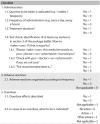Package leaflets of the most consumed medicines in Portugal: safety and regulatory compliance issues. A descriptive study
- PMID: 25337666
- PMCID: PMC10496630
- DOI: 10.1590/1516-3180.2013.7860023
Package leaflets of the most consumed medicines in Portugal: safety and regulatory compliance issues. A descriptive study
Abstract
Context and objectives: Package leaflets are necessary for safe use of medicines. The aims of the present study were: 1) to assess the compliance between the content of the package leaflets and the specifications of the pharmaceutical regulations; and 2) to identify potential safety issues for patients.
Design and setting: Qualitative descriptive study, involving all the package leaflets of branded medicines from the three most consumed therapeutic groups in Portugal, analyzed in the Department of Pharmacoepidemiology, School of Pharmacy, University of Lisbon.
Methods: A checklist validated through an expert consensus process was used to gather the data. The content of each package leaflet in the sample was classified as compliant or non-compliant with compulsory regulatory issues (i.e. stated dosage and descriptions of adverse reactions) and optional regulatory issues (i.e. adverse reaction frequency, symptoms and procedures in cases of overdose).
Results: A total of 651 package leaflets were identified. Overall, the package leaflets were found to be compliant with the compulsory regulatory issues. However, the optional regulatory issues were only addressed in around half of the sample of package leaflets, which made it possible to identify some situations of potentially compromised drug safety.
Conclusion: Ideally, the methodologies for package leaflet approval should be reviewed and optimized as a way of ensuring the inclusion of the minimum essential information for safe use of medicines.
CONTEXTO E OBJETIVO:: As bulas dos medicamentos são necessárias para a sua utilização segura. Os objetivos do presente estudo foram: 1) avaliar a adequação entre o conteúdo das bulas e as especificações da regulação farmacêutica e 2) identificar os aspectos que potencialmente possam comprometer a utilização segura dos medicamentos pelos doentes.
TIPO DE ESTUDO E LOCAL:: Estudo descritivo qualitativo com a inclusão de todas as bulas dos medicamentos de marca dos três grupos terapêuticos mais consumidos em Portugal, analisados no Departamento de Farmacoepidemiologia da Faculdade de Farmácia da Universidade de Lisboa.
MÉTODOS:: Utilização de uma checklist para recolher os dados. A checklist foi validada por um processo de consenso entre peritos. O conteúdo de cada uma das bulas da amostra foi classificado em relação à adequação aos aspectos regulatórios obrigatórios, como a descrição das reações adversas, dose e frequência de administração, e à adequação dos aspectos regulatórios facultativos, como a frequência das reações adversas e sintomas e procedimentos em caso de sobredosagem.
RESULTADOS:: Foram identificadas 651 bulas. Em termos gerais, todas as bulas foram consideradas conformes em relação aos aspectos regulatórios obrigatórios. No entanto, os aspectos regulatórios opcionais foram descritos em apenas cerca de metade da amostra de bulas, o que permite a identificação de situações susceptíveis de comprometer a utilização segura dos medicamentos.
CONCLUSÃO:: Idealmente as metodologias de aprovação das bulas devem ser revistas e otimizadas de forma a assegurar um mínimo de informação essencial para a utilização segura dos medicamentos.
Conflict of interest statement
Figures
Similar articles
-
Validation of a new tool for evaluating subjects' satisfaction with medicine package leaflets: a cross-sectional descriptive study.Sao Paulo Med J. 2019 Sep-Oct;137(5):454-462. doi: 10.1590/1516-3180.2019.0123160919. Sao Paulo Med J. 2019. PMID: 31939571 Free PMC article.
-
[Problems identified in the package leaflets of the Portuguese non-generic medicines].Acta Med Port. 2015 Jan-Feb;28(1):21-8. Epub 2015 Feb 27. Acta Med Port. 2015. PMID: 25817494 Portuguese.
-
Graphical content of medicinal package inserts: an exploratory study to evaluate potential legibility issues.Health Info Libr J. 2016 Jun;33(2):121-39. doi: 10.1111/hir.12128. Epub 2015 Dec 7. Health Info Libr J. 2016. PMID: 26640041
-
Benefits and challenges of electronic package leaflet (ePL) - review of ePL pilots in hospital settings in Europe.Eur J Pharm Sci. 2023 Dec 1;191:106605. doi: 10.1016/j.ejps.2023.106605. Epub 2023 Oct 10. Eur J Pharm Sci. 2023. PMID: 37821011 Review.
-
Future development of global regulations of Chinese herbal products.J Ethnopharmacol. 2012 Apr 10;140(3):568-86. doi: 10.1016/j.jep.2012.02.029. Epub 2012 Feb 25. J Ethnopharmacol. 2012. PMID: 22373513 Review.
Cited by
-
Analysis of the data on pregnancy and lactation provided by patient information leaflets of anti-rheumatic drugs in Argentina.Rheumatol Int. 2018 Apr;38(4):669-673. doi: 10.1007/s00296-018-3931-6. Epub 2018 Jan 13. Rheumatol Int. 2018. PMID: 29332199
-
Validation of a new tool for evaluating subjects' satisfaction with medicine package leaflets: a cross-sectional descriptive study.Sao Paulo Med J. 2019 Sep-Oct;137(5):454-462. doi: 10.1590/1516-3180.2019.0123160919. Sao Paulo Med J. 2019. PMID: 31939571 Free PMC article.
-
Factors influencing subjects' comprehension of a set of medicine package inserts.Int J Clin Pharm. 2016 Aug;38(4):888-98. doi: 10.1007/s11096-016-0305-6. Epub 2016 Apr 23. Int J Clin Pharm. 2016. PMID: 27107582
References
-
- Shiffman S, Gerlach KK, Sembower MA, Rohay JM. Consumer understanding of prescription drug information: an illustration using an antidepressant medication. Ann Pharmacother. 2011;45(4):452–458. - PubMed
-
- European Medicines Agency . Product-information Templates: Quality Review of Documents human product information template version 8. http://www.emea.europa.eu/ema/index.jsp?curl=pages/regulation/document_l... Accessed in 2014 (May 6)
-
- Wolf A, Fuchs J, Schweim HG. QRD template texts intended for package inserts. Pharmazeutische Industrie. 2012;74(9):1540–1549. http://paint-consult.de/de/publikation/pdf/PAINT-Consult_QRD_template_de... Accessed in 2014 (May 6)
-
- Sless D, Wiseman R. Writing about medicines for people: usability guidelines for consumer medicine information. 2. Australia: Department of Health and Family; 1997.
Publication types
MeSH terms
LinkOut - more resources
Full Text Sources
Other Literature Sources






